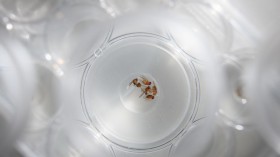CRISPR/Cas9
-

Researchers Develop Faster and More Efficient Way To Study Muscle Diseases
To study muscle diseases, scientists rely on the mouse as a model organism. Researchers at the University of Basel have now developed a new method that is not only faster and more efficient than conventional ones but also greatly reduces the number of experimental animals needed for studying the function of genes in muscle fibers.
Latest Research Articles
-
Scientists Eliminate HIV in Live Animals for the First Time Using CRISPR Gene Editing Technique
-
The Rise of the Ancient Beast: Harvard Team to De-extinct Woolly Mammoths in 2 Years
-
Chimeras and How They Work: What It Meant When Researchers Built the First Human-Pig Hybrid
-
Gene-Editing Technology for Free? MIT, Harvard, UC in Heated Debate to Privatize CRISPR
-
New CRISPR Experiment Corrects Clotting in Mice
-
Swedish Scientist Edits DNA of Healthy Human Embryo Amidst Safety, Ethical Concerns
-
First Ever CRISPR Gene-Editing Trial on Human to Begin in China
-
A New Generation Of Genetically Modified White Mushrooms Is Here, But There’s A Catch
-
HIV Cure Update: Deadly Virus Can Develop Resistance To New Cure





